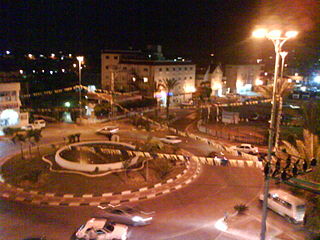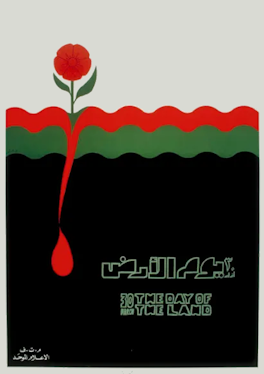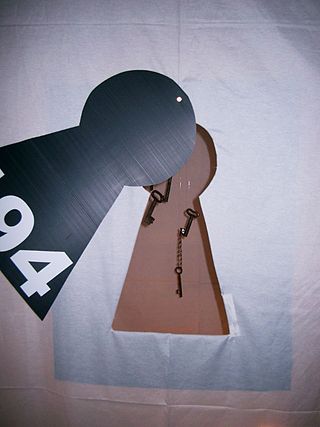Related Research Articles
In economics, an absentee landlord is a person who owns and rents out a profit-earning property, but does not live within the property's local economic region. The term "absentee ownership" was popularised by economist Thorstein Veblen's 1923 book of the same name, Absentee Ownership. Overall, tax policy seems to favour absentee ownership. However, some jurisdictions seek to extract money from absentee owners by taxing land. Absentee ownership has sometimes put the absentee owners at risk of loss.

Iqrit was a Palestinian Christian village, located 25 kilometres northeast of Acre, in the western Galilee. In October 1948, the village's Palestinian Arab inhabitants were expelled by Zionist forces during the 1948 Palestine war, and the territory later became part of the new State of Israel. All of its Palestinian Christian inhabitants were forced to flee to Lebanon or the Israeli village of Rameh, and, despite the promise that they would be returned in two weeks' time, the villagers were not allowed to return, and the Israeli army destroyed the village.

Tira is an Arab city in the Central District of Israel. Part of the Triangle, a concentration of Arab towns and villages adjacent to the Green Line, Tira is close to Kfar Saba. It is known for its weekly market and Arab cuisine.

Ma'alul was a Palestinian village, with a mixed population of primarily Muslims with a substantial minority of Palestinian Christians, that was depopulated and destroyed by Israel during the 1948 Arab-Israeli war. Located six kilometers west of the city of Nazareth, many of its inhabitants became internally displaced refugees, after taking refuge in Nazareth and the neighbouring town of Yafa an-Naseriyye. Despite having never left the territory that came to form part of Israel, the majority of the villagers of Maalul, and other Palestinian villages like Andor and Al-Mujidal, were declared "absentees", allowing the confiscation of their land under the Absentees Property Law.

The Arab citizens of Israel form the country's largest ethnic minority. Their community mainly consists of former Mandatory Palestine citizens who continued to inhabit the territory that was acknowledged as Israeli by the 1949 Armistice Agreements. Notions of identity among Israel's Arab citizens are complex, encompassing civic, religious, and ethnic components. Some sources report that the majority of Arabs in Israel prefer to be identified as Palestinian citizens of Israel, while recent surveys indicate that most name "Israeli", "Israeli-Arab", or "Arab" as the most important components of their identity, reflecting a shift of "Israelization" among the community.

Land Day, recurring on March 30, is a day of commemoration for Palestinians, both Arab citizens of Israel and those in the Israeli-occupied territories of the events of that date in 1976 in Israel.

Romema is a neighbourhood in northwest Jerusalem, just off the Tel Aviv-Jerusalem highway at the main entrance to the city. It occupies the highest hill in Jerusalem. Romema is bordered by Kiryat Mattersdorf and Mekor Baruch.

The Palestinian right of return is the political position or principle that Palestinian refugees, both first-generation refugees and their descendants, have a right to return and a right to the property they themselves or their forebears left behind or were forced to leave in what is now Israel and the Palestinian territories during the 1948 Palestinian expulsion and flight and the 1967 Six-Day War.
Land and property laws in Israel are the property law component of Israeli law, providing the legal framework for the ownership and other in rem rights towards all forms of property in Israel, including real estate (land) and movable property. Besides tangible property, economic rights are also usually treated as property, in addition to being covered by the law of obligations.

Sheikh Jarrah is a predominantly Palestinian neighborhood in East Jerusalem, two kilometres north of the Old City, on the road to Mount Scopus. It received its name from the 13th-century tomb of Hussam al-Din al-Jarrahi, a physician of Saladin, located within its vicinity. The modern neighborhood was founded in 1865 and gradually became a residential center of Jerusalem's Muslim elite, particularly the al-Husayni family. After the 1948 Arab–Israeli War, it became under Jordanian-held East Jerusalem, bordering the no-man's land area with Israeli-held West Jerusalem until Israel occupied the neighborhood in the 1967 Six-Day War. Most of its present Palestinian population is said to come from refugees expelled from Jerusalem's Talbiya neighbourhood in 1948.
The Custodian of Enemy Property is an institution that handles property claims created by war. In wartime, civilian property may be left behind or taken by the occupying state. In ancient times, such property was considered war loot, and the legal right of the winner. In the Fourth Geneva Convention Article 147, such action is defined as war crime:
"Grave breaches to which the preceding Article relates shall be those involving any of the following acts, if committed against persons or property protected by the present Convention: willful killing, torture or inhuman treatment, including biological experiments, willfully causing great suffering or serious injury to body or health, unlawful deportation or transfer or unlawful confinement of a protected person, compelling a protected person to serve in the forces of a hostile Power, or willfully depriving a protected person of the rights of fair and regular trial prescribed in the present Convention, taking of hostages and extensive destruction and appropriation of property not justified by military necessity and carried out unlawfully and wantonly."
Ir David Foundation or City of David Foundation, commonly known as Elad [El'ad], is a Jerusalem-based Israeli settler association which aims to strengthen the Jewish connection to Jerusalem, and renew the Jewish community in the City of David, which is also part of the neighborhood of Silwan. The foundation works to achieve its goals by tourism, education, archaeological excavations and obtaining homes in the area to establish a Jewish presence.
In the 1948 Palestine war, more than 700,000 Palestinian Arabs – about half of Mandatory Palestine's predominantly Arab population – were expelled or fled from their homes, at first by Zionist paramilitaries, and after the establishment of Israel, by its military. The expulsion and flight was a central component of the fracturing, dispossession, and displacement of Palestinian society, known as the Nakba. Dozens of massacres targeting Arabs were conducted by Israeli military forces and between 400 and 600 Palestinian villages were destroyed. Village wells were poisoned in a biological warfare programme and properties were looted to prevent Palestinian refugees from returning. Other sites were subject to Hebraization of Palestinian place names.
An Israeli military order is a general order issued by an Israeli military commander over territory under Israeli military occupation. It has the force of law. Enforcement of such orders is carried out by Israeli military police and military courts instead of civil courts.

The Trading with the Enemy Act 1939 is an Act of the Parliament of the United Kingdom which makes it a criminal offence to conduct trade with the enemy in wartime, with a penalty of up to seven years' imprisonment. The bill passed rapidly through Parliament in just two days, from 3 to 5 September 1939, and the Act was passed on 5 September 1939, at the beginning of the Second World War. It is still in force.

The Shepherd Hotel was a hotel in the Sheikh Jarrah neighborhood of East Jerusalem.

Present absentees are Arab internally displaced persons (IDPs) who fled or were expelled from their homes in Mandatory Palestine during the 1947–1949 Palestine war but remained within the area that became the state of Israel.
Land expropriation in the West Bank refers to the practices employed by the State of Israel to take over Palestinian land in the occupied West Bank. From 1969 to 2019 Israel had issued over 1,150 military seizure orders alone to that purpose.

The Sheikh Jarrah controversy, which has been described as a "property/real estate dispute" by the Israeli government and its supporters, and as an "expulsion", "displacement" or "ethnic cleansing" event and a matter of international law by Palestinians and their supporters, is a long-running legal and political dispute between Palestinians and Israelis over the ownership of certain properties and housing units in Sheikh Jarrah, East Jerusalem. The evictions are considered a contributory cause of the 2021 Israel–Palestine crisis.

Palestinian displacement in East Jerusalem is the transfer of Palestinian residents from the city due to Israeli policies aimed at an Israeli-Jewish demographic majority. Many Palestinian families in East Jerusalem have been affected by "forced relocation processes or been involved in lengthy legal procedures to revoke an eviction order." According to the United Nations Office for the Coordination of Humanitarian Affairs (OCHA), between a third to a half of East Jerusalem's houses do not have permits, potentially placing over 100,000 Palestinian residents of the city at risk of forced displacement and forcible transfer as a result of demolitions.
References
- ↑ Morris, Benny (2004). The Birth of the Refugee Problem Revisited, Cambridge University Press, p. 467.